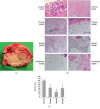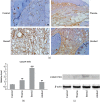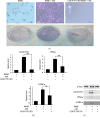Increased COUP-TFII Expression Mediates the Differentiation Imbalance of Bone Marrow-Derived Mesenchymal Stem Cells in Femoral Head Osteonecrosis
- PMID: 31886265
- PMCID: PMC6925929
- DOI: 10.1155/2019/9262430
Increased COUP-TFII Expression Mediates the Differentiation Imbalance of Bone Marrow-Derived Mesenchymal Stem Cells in Femoral Head Osteonecrosis
Abstract
Objective: Bone marrow-derived mesenchymal stem cells (BMSCs) have multilineage differentiation potential, which allows them to progress to osteogenesis, adipogenesis, and chondrogenesis. An imbalance of differentiation between osteogenesis and adipogenesis will result in pathologic conditions inside the bone. This type of imbalance is also one of the pathological findings in osteonecrosis of the femoral head (ONFH). Chicken ovalbumin upstream promoter-transcription factor II (COUP-TFII) was previously reported to mediate the differentiation of mesenchymal stem cells. This study investigated the expression of the osteogenesis regulator Runx2, osteocalcin, the adipogenesis regulator PPARγ, and COUP-TFII in the femoral head tissue harvested from ONFH patients, and characterized the effect of COUP-TFII on the differentiation of primary BMSCs.
Methods: Thirty patients with ONFH were recruited and separated into 3 groups: the trauma-, steroid- and alcohol-induced ONFH groups (10 patients each). Bone specimens were harvested from patients who underwent hip arthroplasty, and another 10 specimens were harvested from femoral neck fracture patients as the control group. Expression of the osteogenesis regulator Runx2, osteocalcin, the adipogenesis regulator PPARγ, C/EBP-α, and COUP-TFII was analyzed by Western blotting. Primary bone marrow mesenchymal cells were harvested from ONFH cells treated with COUP-TFII RNA interference to evaluate the effect of COUP-TFII on MSCs.
Results: ONFH patients had significantly increased expression of the adipogenesis regulator PPARγ and C/EBP-α and decreased expression of the osteogenesis regulator osteocalcin. ONFH bone tissue also revealed higher COUP-TFII expression. Immunohistochemical staining displayed strong COUP-TFII immunoreactivity adjacent to osteonecrotic trabecular bone. Increased COUP-TFII expression in the bone tissue correlated with increased PPARγ and decreased osteocalcin expression. Knockdown of COUP-TFII with siRNA in BMSCs reduced adipogenesis and increased osteogenesis in mesenchymal cells.
Conclusion: Increased COUP-TFII expression mediates the imbalance of BMSC differentiation and progression to ONFH in patients. This study might reveal a new target in the treatment of ONFH.
Copyright © 2019 Sheng-Hao Wang et al.
Conflict of interest statement
The authors declare that they have no conflicts of interest.
Figures






Similar articles
-
Icariin Protects against Glucocorticoid-Induced Osteonecrosis of the Femoral Head in Rats.Cell Physiol Biochem. 2018;47(2):694-706. doi: 10.1159/000490023. Epub 2018 May 22. Cell Physiol Biochem. 2018. PMID: 29794448
-
MicroRNA-194 reciprocally stimulates osteogenesis and inhibits adipogenesis via regulating COUP-TFII expression.Cell Death Dis. 2014 Nov 20;5(11):e1532. doi: 10.1038/cddis.2014.485. Cell Death Dis. 2014. PMID: 25412310 Free PMC article.
-
P-glycoprotein overexpression in bone marrow-derived multipotent stromal cells decreases the risk of steroid-induced osteonecrosis in the femoral head.J Cell Mol Med. 2016 Nov;20(11):2173-2182. doi: 10.1111/jcmm.12917. Epub 2016 Jul 11. J Cell Mol Med. 2016. PMID: 27396977 Free PMC article.
-
Recent advances in osteonecrosis of the femoral head: a focus on mesenchymal stem cells and adipocytes.J Transl Med. 2025 May 27;23(1):592. doi: 10.1186/s12967-025-06564-6. J Transl Med. 2025. PMID: 40426076 Free PMC article. Review.
-
The shift in the balance between osteoblastogenesis and adipogenesis of mesenchymal stem cells mediated by glucocorticoid receptor.Stem Cell Res Ther. 2019 Dec 5;10(1):377. doi: 10.1186/s13287-019-1498-0. Stem Cell Res Ther. 2019. PMID: 31805987 Free PMC article. Review.
Cited by
-
microRNA-148a-3p in extracellular vesicles derived from bone marrow mesenchymal stem cells suppresses SMURF1 to prevent osteonecrosis of femoral head.J Cell Mol Med. 2020 Oct;24(19):11512-11523. doi: 10.1111/jcmm.15766. Epub 2020 Sep 1. J Cell Mol Med. 2020. PMID: 32871042 Free PMC article.
-
miR-21 regulates osteogenic and adipogenic differentiation of BMSCs by targeting PTEN.J Musculoskelet Neuronal Interact. 2021 Dec 1;21(4):568-576. J Musculoskelet Neuronal Interact. 2021. PMID: 34854397 Free PMC article.
-
Synovial Mesenchymal Stem Cell-Derived EV-Packaged miR-31 Downregulates Histone Demethylase KDM2A to Prevent Knee Osteoarthritis.Mol Ther Nucleic Acids. 2020 Sep 16;22:1078-1091. doi: 10.1016/j.omtn.2020.09.014. eCollection 2020 Dec 4. Mol Ther Nucleic Acids. 2020. PMID: 33294294 Free PMC article.
-
Mesenchymal Stem Cell Therapy for Bone Repair of Human Hip Osteonecrosis with Bilateral Match-Control Evaluation: Impact of Tissue Source, Cell Count, Disease Stage, and Volume Size on 908 Hips.Cells. 2024 May 1;13(9):776. doi: 10.3390/cells13090776. Cells. 2024. PMID: 38727312 Free PMC article.
References
-
- Mont M. A., Hungerford D. S. Non-traumatic avascular necrosis of the femoral head. The Journal of Bone and Joint Surgery American Volume. 1995;77(3):459–474. - PubMed
-
- Lavernia C. J., Sierra R. J., Grieco F. R. Osteonecrosis of the femoral head. The Journal of the American Academy of Orthopaedic Surgeons. 1999;7(4):250–261. - PubMed
MeSH terms
Substances
LinkOut - more resources
Full Text Sources

